This section will be available this Autumn.

Almine Rech
vivian springford
untitled
Vivian Springford (USA, Wisconsin 1913-2003 New York) Untitled, circa 1973 Acrylic on canvas 182.9 x 183.5 x 3.2 cm Provenance: estate of the artist Exhibition: Almine Rech, 'Gesture & Form: Women in Abstraction', May 3rd - June 15th, 2024, New York, Upper East Side Vivian Springford’s 'Untitled', circa 1973, encapsulates the American painter’s expressive, vibrant style. During the late 1960s, Springford had come into her own as an artist. She had developed a signature visual vocabulary and a technique of stain painting to go with it, working with thinned paint to create kaleidoscopic, gestural works.

Victor Werner
carl johan bonnesen
Carl Johan Bonnesen (Aalborg 1868-1933 Copenhagen) African elephant, 1924 Bronze with green patina H 54 x W 78 x D 34 cm Signed and dated CARL J. BONNESEN 1924 Provenance: Professor Karl Meyer, board member of Villadsens Fabrikker; donated Nov. 9th, 1932, to the company director Christian Villadsen and his wife Ingeborg (as inscribed on the base); gifted by Christian Villadsen’s grandson to the previous owner

Galerie Boulakia
Joan Miró (Barcelona 1893-1983 Palma) Untitled, 1946 Pen and India ink, coloured pencils, and pencil on paper 30 x 24 cm Signed, dated and inscribed 'Miró. 23-7-1946 à mon cher Joan Gomis, le jour de son anniversaire' (to my dear Jean Gomis on the day of his birthday) Provenance: Pierre Matisse Gallery, New York; Joaquim Gomis i Serdañons, Barcelone Literature: Jacques Dupin, Ariane Lelong-Mainaud, Joan Miro : catalogue raisonné, Volume II, 1931-1941, Editions Maeght-Lelong, Paris, 2000, n° 1. 1078, ill. p. 144

TEMPLON
Martial Raysse (Nice, 1936) Now, 2017 Acrylic on canvas 209 x 175.5 cm Unique Provenance: the artist’s studio Literature: exhibition catalogue Martial Raysse: œuvres récentes, Musée Paul Valéry, Sète, France: Ed. Loubatières 2023, ill. p. 151 Exhibition: Martial Raysse: œuvres récentes, Musée Paul Valéry, Sète France, 2023
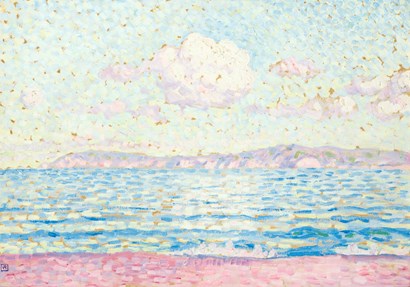
Galerie Raf Van Severen
théo van rysselberghe
Théo Van Rysselberghe (Belgium, Ghent 1862-1926 Le Lavandou, France) Ile du Levant, circa 1904 Oil on panel 30 x 41.4 cm Signed with monogram bottom left Provenance: Foundation Catherine Gide; private collection, Brussels Literature: Feltkamp, 2003, réf. 1924-034, p. 441; Catalogue de l'exposition, Bruxelles, La Haye, 2006, p. 258; Théo Van Rysselberghe, l'instant sublimé, Museé de Lodève, 2012, p. 99; Théo Van Rysselberghe, Intime, 2005, p.65; Théo Van Rysselberghe, Bozar Books by Fonds Mercator & Palais Des Beaux-Arts, Belgian Art Research Institute, 2005, p. 229 Exhibitions: 2005, TVR, Intime, Espace Culturel, Le Lavandou, n° 37; 2006, Brussels, La Haye, without number, p. 229

Galerie Bernard De Leye
Umbilicated dish and gadrooned basin in enameled copper Venise, circa 1500-1530 Ø 33 cm Provenance: collection Messel, Darmstadt; collection Ludwig and Anne Messel, London; collection Leonard and Maud Messel, London until 1953; Galerie Kugel, Paris; private collection, Switzerland Literature: Les cuivres émaillés dits Vénitiens, Corpus des œuvres en collections publiques et privées, Silvana Editoriale, 2018, Volume II, n° 34, p. 92 Twelve convex, curved white gadroons with blue highlights on a green background. This enamel production in Venice spans over a very short period within Venetian Decorative Arts. The basin is adorned with two rows of 24 concave, curved gadroons, then with scale-like motifs. The entirely blue reverse is richly decorated with gilded patterns.
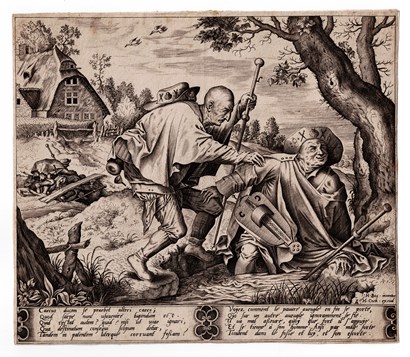
Chambre professionnelle belge de la Librairie Ancienne et Moderne (CLAM)
Hieronymus Bosch ('s-Hertogenbosch, circa 1450-1516) Parable of the two blind men, circa 1540-1570 Engraving by Pieter van der Heyden (circa 1530-1572) Published by Hieronymus Cock (Antwerp, 1518-1570) 22.2 x 22.5 cm References: New Hollstein Dutch 20 1(5), first state Lex Antiqua, Antiquarian printseller
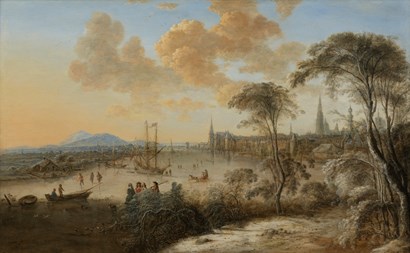
COLNAGHI
Gillis Neyts (Ghent 1623-1687 Antwerp) A winter cityscape of Antwerp, 1666 Oil on panel 54 x 86 cm Signed and dated lower left: g. nyts. f. / 1666 Provenance: sale Fievez, Brussels (16 June 1931), lot 113; sale of the F. Stuyck collection, Brussels, Palais des Beaux-Arts (7-8 December 1960), lot 91; Galerie P. de Boer, Amsterdam (1961) n° 54; Laboratoria Tupens, Sint-Niklaas (?); with Rafael Valls, London; with De Jonckheere, from whom acquired by the present owner Literature: P. Gustot, Gillis Neyts. Un paysagiste brabançon en vallée mosane au XVIIe siècle, Namur, 2008, p. 69, n° P13, repr. Exhibition: Brussels, Musées Royaux des Beaux-Arts de Belgique, Le siècle de Rubens, 15 October-12 December 1965, n° 157, repr.

Romigioli Antichità
portrait of bona di savoia
Giovanni Cristoforo Ganti Detto Gian Cristoforo Romano (cerchia di) Roma ? 1460/5 – Loreto 1512 Portrait of a Lady (Bona di Savoia, Duchess of Milan?) 1490-5 White marble relief, diameter 50 cm Scientific profile by Alfredo Bellandi and Giancarlo Gentilini 2012 Published in A. Rinetti "The Duke's City, Ducal Portraits"
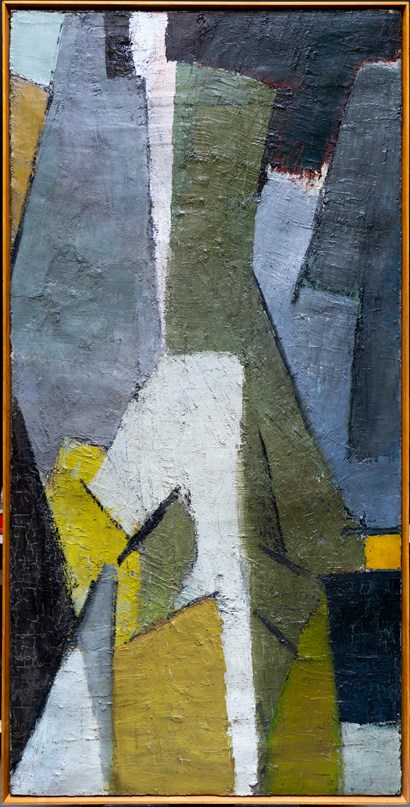
CKS Gallery
nicolas de stael
Nicolas de Staël (Saint Petersburg 1914-1955 Antibes) Composition, 1949 Oil on canvas 200 x 100 cm Provenance: private collection of the artist Literature: Françoise de Staël, Nicolas de Staël, Catalogue Raisonné de l'oeuvre peint, Paris, 1997, n° 203 Exhibitions: Hôtel de Caumont, Aix-en-Provence, 27 April-23 September 2018, Nicolas de Staël en Provence; Château Grimaldi d’Antibes, 17 May-7 September 2014, exhibition La figure à nu, hommage à Nicolas de Staël; MuMa – Musée d’Art Moderne André Malraux, Lumières du Nord, Lumières du Sud, 7 June-9 November 2014; Académie Royale des Beaux-Arts de Bruxelles, Belgium, 2012, for the 300th anniversary of the Académie Royale where de Staël studied from 1931 to 1934, 9 May-2 June 2012; Fondation Gianadda de Martigny, Switzerland, retrospective of the work of Nicolas de Staël, 18 June-21 November 2010; Centre Pompidou, Nicolas de Staël 1945-1955, Paris, 12 March-30 June 2003; Musée d'Art Moderne, Paris, Retrospective Nicolas de Staël, 15 September 2023-21 January 2024; Fondation de l’Hermitage, Lausanne, Nicolas de Staël Exhibition, 9 February-9 June 2024
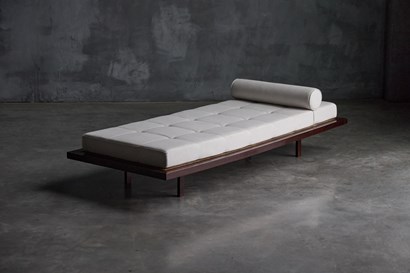
Laurent Schaubroeck
Jorge Zalszupin (Warsaw 1922-2020 São Paulo) Minimalist daybed, Brazil, 1963 Jacaranda, Brazilian rosewood, upholstery H 35 x W 191 x D 80 cm Provenance: Ina Zalszupin (sister of the artist) One of only two ever produced, this exceptionally rare daybed was crafted in 1963 as a personal gift for the designer’s sister, Ina Zalszupin. Its minimalist wooden frame displays a warm patina and supports a refined off-white mattress - an extraordinary example of mid-century Brazilian modernism.
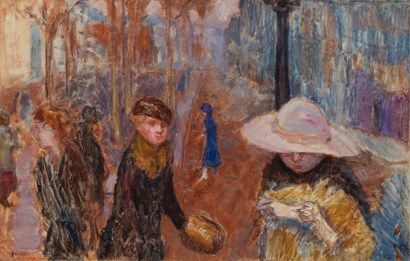
Galerie Alexis Pentcheff
pierre bonnard
Pierre Bonnard (Fontenay-aux-Roses 1867-1947 Le Cannet) Promenade à Paris, circa 1911 Oil on canvas 40 x 60 cm Estate stamp lower left Provenance: collection of Pierre and Marie-Françoise Vernon Literature: Dauberville Jean et Henry, Bonnard, Vol. IV, Paris, Bernheim-Jeune, 1974, repr. p. 312 under n° 01992 Exhibitions: Pierre Bonnard, A. Tooth & Sons, London, 17 June-12 July 1969, repr. in exh. cat. n° 8; Matisse e Bonnard. Viva la pittura!, Rome, 2006, repr. in exh. cat. (ed. Skira) p. 340 under n° 125; Bonnard, Le Cannet, une évidence, Musée Bonnard, Le Cannet, 2020, repr. in exh. cat. p. 42 The creation of this work by Pierre Bonnard reminds us that the artist was also a photographer, experimenting with daring compositions. Though his painting captures the fleeting moment, it shares little with the tentative realism of early photography. Made entirely of color and sensation, it constructs a fragile world of subtle harmony. Just before embracing the South - before letting the Mediterranean light burst into color across his canvases - Bonnard explored a quieter, more muted sensuality in the early 1910s, while working in a studio in Paris, not far from the avenue depicted here. The “very Japanese Nabi,” as his friends from the group of his youth liked to call him, knew how to let color whisper on the canvas, how to conjure the intimacy of a letter. On one side of the painting, cool tones — blues and violets placed side by side - contrast with the russet hues of this autumnal Parisian avenue, bringing to the foreground, beneath a hat bathed in light like a reinvented halo, the lowered face of a woman reading. Her eyes are hidden, absorbed in the text. Though she has removed her gloves, she surely no longer feels the sharp chill of that November afternoon… Elegant silhouettes glide through the landscape; yet they endure — along with this hat-wearing heroine - on our retinas and in our memories, as companions to a shared intimacy, lasting only the time it takes to read a love letter. Unseen on the art market since the 1960s, this painting has been shown in several museum exhibitions, the most recent in 2020 at the Musée du Cannet, dedicated to the artist.

Serge Schoffel - Art Premier
Sitting male figure Timoto-Cuica, 900-1300 AD Trujillo State, Venezuela Terracotta, pigments H 29 x W 23 x D 17.5 cm Datation: TL test n° 481z12 by the Research Laboratory for Archaeology, Oxford University, United Kingdom, on 7 May 1991 Provenance: Galerie Ferrero, Geneva, 1968; collection Barbier-Mueller, Geneva, Inv. n° 530-2; Sotheby's auction, Paris, collection Barbier-Mueller-Art Précolombien, on 22 and 23 March 2013, n° 265 Literature: Paz, Octavio, Butor, Michel, Barbier, Jean-Paul, Stierlin, Henri, Lavallée, Danièle, Conceição G., Corrêa, Barry, Iris, 1992, Art millénaire des Amériques : de la découverte à l'admiration, 1492-1992, Arthaud, fig. 130, p. 178 & 179; Conceição G., Corrêa, Barry, Iris, 2002, Amazonie précolombienne, Museo Barbier-Mueller de Arte Precolombino, Barcelona, 5 Continents, fig. 4, p. 17; Benson, Elizabeth P., 2003, Trésors de la céramique précolombienne du Museo Barbier-Mueller de Arte Precolombino de Barcelona, Musée Barbier-Mueller et Somogy éditions d’art, fig. 44, p. 52
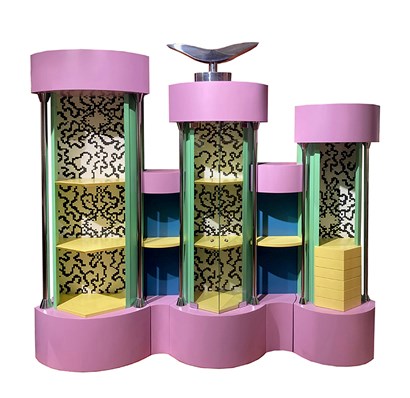
robertaebasta
Alessandro Mendini (Milan, 1931-2019) 'Libreria scultura' prototype of modular bookcase/display for Swatch, Italy 1994 Lacquered wood, coloured, laminated, chromed and satin steel H 214 x W 250 x D 40 cm Unique piece Certificate of authenticity by Mrs Elisa Mendini and Mrs Fulvia Mendini Provenance: private collection, Italy

Galerie de la Présidence
Nicolas de Staël (Saint Petersbourg 1913-1955 Antibes) Composition, 1949 Oil on canvas 38 x 46 cm Signed lower left Provenance: Henriette Gomès collection, Paris; private collection, Paris; private collection, Luxembourg Literature: J-P Jouffroy, Nicolas de Staël, p. 161; Jacques Dubourg and Françoise de Staël, Nicolas de Staël, Catalogue Raisonné des peintures, ed. Le temps, Paris, n° 195, p. 121; Françoise de Staël, Nicolas de Staël, Catalogue Raisonné des peintures, ed. Ides et Calendres, Switzerland, n° 189, p. 259; Françoise de Staël, Nicolas de Staël, Catalogue Raisonné des peintures, ed. Ides et Calendres, Switzerland, revised and expanded by Marie du Bouchet and Gustave de Staël, n° 189, p. 209 Exhibition: Nicolas de Staël, Musée Réattu, Arles, June-September 1958, n° 18 The year 1949 was a crucial period for Nicolas de Staël: he continued to explore and refine his style, marking an important transition towards painting that would become more fluid and expressive. Among his notable works this year is this 'Composition', which reflects his continued use of thick layers of paint and his extensive play with materials, moving from impasto to knife painting. For Nicolas de Staël, although abstract his paintings are 'images of life', his coloured masses generate vibrations. Lastly, this painting has always been kept in private hands until now, and was never presented at auctions.

Galerie Florence de Voldère
frederik bouttats l'ancien
Frédérik Bouttats the Elder (Antwerp, 1590-1661) Earthly paradise Oil on canvas 55.5 x 83 cm A painter of landscapes, paradises, and animals, he was also an engraver. He joined the Antwerp Guild as early as 1612. He had two pupils, as well as his sons Frédérik the Younger and Jacob. Founder of a famous family of artists, he contributed, along with his followers, to the influence and richness of Flemish painting through brilliant works under the influence of Velvet Brueghel, Jan van Kessel, and Roelandt Savery. To the great delight of naturalists and humanist scholars, the Breughels and their painter friends such as the Bouttats multiplied the themes of the Earthly Paradise, celebrating the beauty and diversity of creation. Like the Bird Traps, these paradises met with great success, and different versions can now be seen in the world’s greatest museums.
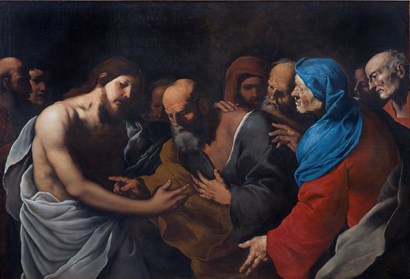
Hartford Fine Art - Lampronti Gallery
Francesco Fracanzano (Monopoli 1612-1656 Naples) The incredulity of Saint Thomas Oil on canvas 143 x 205 cm Literature: R. Causa, La pittura del Seicento a Napoli. Dal naturalismo al barocco, Naples, 1972, S. 976, n° 74; G. De Vito, Fracanziano’s periphrasis in XVII century Neapolitan studies, 2003/2004, pp. 104-105, fig. 2; N. Spinosa, XVII c. paintings in Naples, from Caravaggio to Massimo Stanzione, Naples 2010, p. 281 cat. n° 212; A. Della Ragione, Francesco Fracanzano, 2011, p. 10, fig. 23; N. Spinosa, Da Artemisia a Hackert. La collezione di un antiquario, exh. cat., Reggia di Caserta, Foligno 2019, cat. 9, pp. 18-19; N. Spinosa, Il Maestro degli Annunci ai pastori e i pittori del 'tremendo impasto' (Napoli 1625-1650), Rome 2021, cat. C5, p. 193 (quoting further literature: Cairo, 2011, pp. 203-210. Forgione, p. 233, fig. 12) Exhibition: Da Artemisia a Hackert. La collezione di un antiquario, Reggia di Caserta, 2019-2020

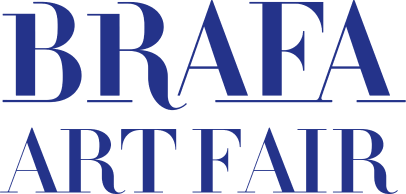


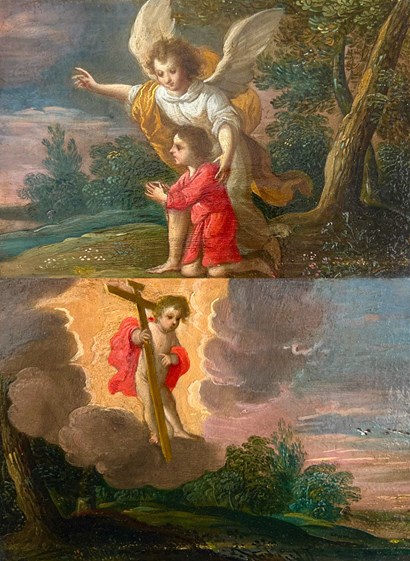








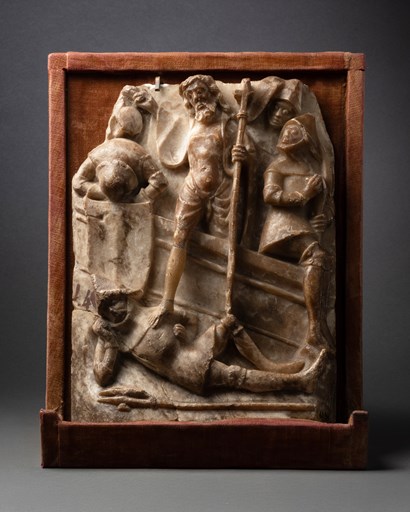
__T638930935598121241.jpg?width=410&height=2000&qlt=90&scale=both&mode=max&format=jpeg)
